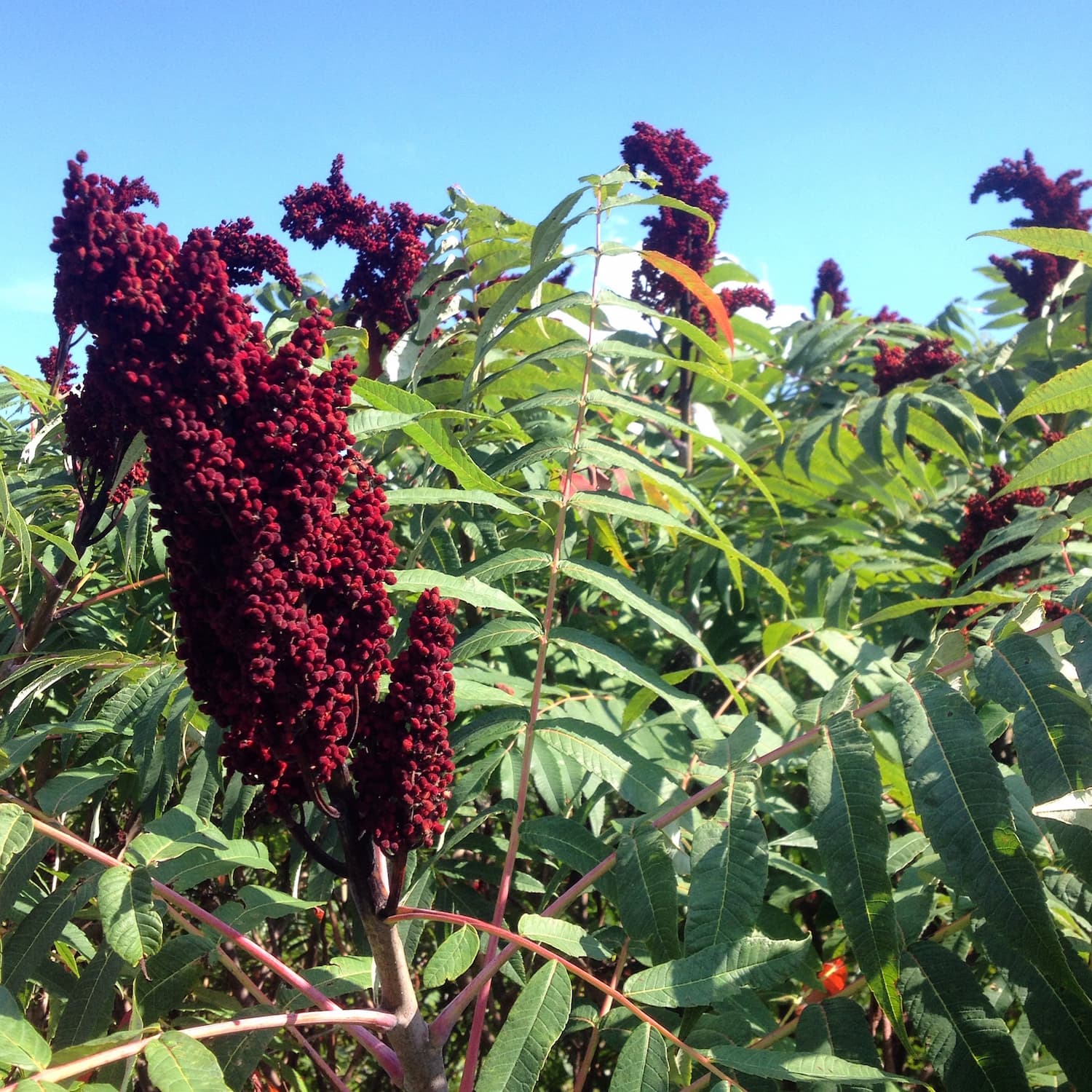How to Identify Sumac — Foraging for Edible Wild Spices
- Authors
- Name
- Sam Sycamore
- @tanoaksam
- Published on
- Last updated
What is sumac?
Let's play a quick word-association game: what comes to mind when I say "sumac"?
Survey says: "Poison!" Right?
Listen, not all sumacs are "poison sumac." I swear! Actual poison sumac (Toxicodendron vernix) isn't in the same genus as our edible sumac species—it's more closely related to poison ivy and poison oak. It's fairly rare unless you happen to spend most of your time in ankle-deep swamps, it's confined to the eastern US, and it's easily differentiated from the good stuff by some very obvious traits.
Now that we're all on the same page here, let's talk about our edible allies in question.

Sumac is a very common and beautiful sight along roadsides throughout the US.
Sumac taxonomy and ecology
The sumacs are a group of 35 species that belong to the Rhus genus in the Anacardiaceae (cashew) family of plants. This family does include those aforementioned "Poison [blank]" species, yes, but it also includes cashews, pistachios, and mangoes.
(As a side note, if you're allergic to those nuts or fruits, you should probably steer clear of sumac, too—sorry for your luck.)
Sumac species are found in all fifty states and throughout Canada, growing essentially everywhere but the cooler, wetter places like parts of the Pacific Northwest, and the hottest, driest places like the extreme deserts of Nevada and Texas. It's also prolific in the Old World and the Middle East.
The two species that I’ve observed most commonly around the Midwest US are R. typhina (staghorn sumac) and R. copallina (winged or shining sumac), but once you develop an eye for this genus they’re all very easy to spot. Many bear very close resemblance to the staghorn.
Where to find sumac
Sumac is common along roadsides and in fencerows—you probably drive past more than a few patches of these bushy trees regularly if you live outside of an urban area in the eastern U.S.—and they require full sun and well-drained, somewhat dry soil to thrive.
Sumac plants generally stand anywhere from 5 to 20 feet tall, and grow in clusters characteristic of plants that clone themselves through root suckers (see also: pawpaws). The leaves are pinnately compound, which is how botanists describe a single leaf that’s composed of many small "leaflets."
What are commonly referred to as sumac "berries" are actually clusters of seeds that ripen from off-white to a deep, dark red through the summertime. The clusters always grow in a distinct cone shape and are easy to harvest by cutting where they attach to the stem of the plant.
Here’s where it becomes a no-brainer to differentiate between poison and edible sumac: T. vernix (the bad stuff) produces fruits in clusters that hang down from the stem and resemble grape clusters. They never mature to red, so even if you did mistake their ghastly, grape-like berries for a Rhus, you wouldn’t pick them because they would appear unripe.
You'll know our friendly sumacs are ripe when you brush your hand across them and pick up a faint citrus-y scent. The window to harvest runs from August in hotter climates through September and October where it's cooler, but the flavor will get weaker each time a heavy rain comes through and washes a little more tasty fuzz off of the seeds.

The fuzzier the sumac berry, the more flavorful it is.
How to use sumac
Sumac berries are much too tart and not especially palatable to attempt to consume directly.
All throughout the Middle East, the fruits of Rhus coriara are ground up into a powder that adds a tart, tangy flavor and a distinct maroon color to many popular dishes
If cooking Middle Eastern cuisine isn't your thing, a simpler use for sumac is to make "sumac-ade," which, as the name suggests, scratches the same sort of itch that a cool glass of lemonade takes care of on a hot summer day.
Here's how you do it: take at least 6 decent-sized berry clusters and squish them into a gallon jug—you don't have to totally pulverize them, but just rough 'em up a bit. Some people will tell you to remove the berries from the stems first, but I don't really think this step is necessary.
Add cold water (not hot, and definitely not boiling—this will bring out tannins and make for a much less pleasant experience) and let it sit somewhere cool and dark for at least an hour or two.
From there, you might want to run your Rhus juice through a cheesecloth or at least a strainer to make sure you get all of the bits of stems and seeds out along with any grubs or other insects who may have been hiding inside. After that, pour your sumac-ade over ice and enjoy! You can sweeten if it you like, but I think you'll find it's just fine as is.
Introduction to Foraging
Did you find this article helpful?
This is an excerpt from Introduction to Foraging: A Beginner's Guide to Gathering Wild Foods With Confidence.
Diving into the wonderful world of wild foods can be intimidating, especially if you don't have much experience working with plants.
Introduction to Foraging was written with the absolute beginner in mind, and with the goal of getting you out into the world gathering wild foods right away.
To learn everything you need to know to begin foraging safely, sustainably, and confidently, check out the book here. Happy hunting!